This is the first time I have invited a guest blogger on my site, Susan who is one of my favorite bread bloggers, she inspires, teaches and alway's bakes beautiful bread. Lately I have been sending her all sorts of formula's and decided to ask her to join in my quest to make a loaf well known to most German forum bakers as "Herr Süpke's Schwarzer Hamsterbrot." Do you know why it is called hamster? Because it looks like hamster food?" Susan asked, but I had no idea except for the fact Herr Süpke's looked good, and all the other bakers on various forums were baking it, that was my reason for wanting to give it a go.
Jeremy's take on this tale
I never liked competition while working in kitchens. Given it's a crazy business, there is already enough stress to go around. Who needs to fight for first prize? But every so often I'm inspired to challenge my skills as either a cook or as a baker. Usually it's a recipe that isn't the usual old pain au levain, a holey ciabatta or baguette. Sometimes you find a great looking loaf, with recipe written in a vaguely familiar tongue you had spoken as a child, only you don't have more then a five-year old child's vocabulary as an adult or less!
All to say I've found a new challenge; a German home-baker's holy grail of seeded rye bread. Baker's percentages and numbers are already a chore, but to decipher German, find similar ingredients and then approach a recipe by no other then the blogger/baker, Wolfgang Süpke, and think you can make his reknowned Schwarzer Hamsterbrot, you got to have some chutzpah.
Well, this bread is more than a bit daunting. Multiple soakers and grains, various flour, sourdough, some yeast. And it demands a myriad of different times that add up to one challenge. I didn't want to go alone again, the last batch went to the garbage pail! So I sent off e-mails, queried the Master baker on his site, and found a message than from no other then Nils, my go to and go between with Herr Süpke.
Nils filled me in to some of what was going awry with my rye! Still I was on shaky ground and needed some company. Maybe another hand in the mix, someone who can guide, coach, push and inspire me to new baking heights, yes I found someone who fit that role, namely I needed Susan from Wild Yeast. I've sent her all sorts of S.O.S's for spreadsheets, not to mention requests to answer easy questions that I should already know. Finally admitting my total lack of true bakers focus, it seemed high time I got off the fence and start training like I was going to the Olympics or something.
I pretty much followed the instructions that I had found on several sites, and translated it as best I could with my widget translator and Google.
" S c h w a r z e r H a m s t e r " Seeded bread with rye sour
Sourdough : ( proof 1 5 – 2 0 Hrs . )
1 2 5 g R ye flour (medium rye)
1 2 5 g W at e r
1 0 g sour
grain soaker :
5 0 g R ye grain whole
5 0 g Spelt o r K a m u t grain
i n 1 5 0 m l W a t r soak for . 3 0 M i n . then 3 0 M i n . boil ,
strain
soaker :
( 1 hour soak )
1 6 0 g Pumpkin seed , Sunflower seed , flax , S e s a me
1 6 0 g W a t e r
2 hours at )
1 1 0 g Rye meal
220 g W a t e r
( soak for 15 mi n )
5 0 g Rye flakes
5 0 g W a te r
Final dough :
2 5 0 g Rye sour
1 3 0 g White whole wheat flour
1 2 g salt
1 0 g yeast
Bread spice, coriander, fennel and caraway(optional 1 tbsp)
grain soaker, seed soaker
Mix - 2 0 M i n . rest , knead briefly to shape - Bread pan 1 k g lightly greased and covered with sunflower seeds
Dough is proofed for 6 0 M i n . B a k e d 484 F lower to 400 F - bake for . 6 0 M i n .
- Rye sour was awakened after a long dormancy in my fridge, neglected of course. Susan told me I should get it nourished and ready for a Saturday bake.
- Rye sour activated, two days of feeding found it vibrant and bubbly!(It's alive!)
- Friday I fed the sour to the proportions stated, next morning I went out and was having lunch when Susan called me an asked me how I was doing on the Hamster!(I was behind schedule, uh oh!)
- So I quickly gathered the rest of my grains, soaker and proceeded with the formula. My rye meal was not cooked, but instead I poured boiling water over it and let it soak up and cool overnight.
- seeds were soaked, probably less time then the should of been, but I was throwing caution to the wind, I was on a tight schedule and I wasn't missing the bus.
- I used spelt flakes also 15 minutes.
I mixed with a paddle on my kitchen aid, had a mashed potato consistency dough, a short 20 minutes rest, then I placed it into a 10×4 inch pan, when I suddenly realized that too much multitasking and rushing around I had forgotten to mix in my cooked grains! After remixing I returned the dough to the pan and let it rise a little more then an hour, it didn't look like it was moving, so I just re-heated oven and popped it in a 485 F oven for 1 hour, with a lowering of the temperature at about the 28th minutes to about
390 F. To my surprise the loaf had a bit of rise and some irregular cracks in the dough, but a nice golden color, I couldn't wait to see Susan's!
Susan's take on this tale 
Well, Jeremy wasn't kidding when he said this was a daunting bread! I love to eat dense German-style seeded breads like this, but I don't have much experience baking them, so I was happy to have the company, to learn, plan and commiserate.
If nothing else, the timing of all the different components was crazy-making:
Rye sour, fermented about 18 hours — done.
Rye meal, cooked and cooled overnight — got it.
Rye and farro grains, cooked and cooled two hours ahead — OK.
Seeds, soaked one hour — check.
Rye flakes, soaked 15 minutes — yes.
Another step outside my comfort zone came when I realized that the final dough has no added water; all the water in the formula comes from the soakers. I generally adjust the amount and temperature of the final dough water to control the consistency and temperature of the dough, so I was nervous.
As it turned out, the dough seemed just the right consistency, but a little on the cool side (about 72F). So I extended the first fermentation to 20 minutes instead of 15, and the final proof an extra 15 minutes beyond the recommended one hour. Even so, the dough rose only a bit in the proof, but still may have been over proofed, as it rose virtually not at all during baking.
I had such high hopes for this loaf, and it was flat and ugly! So I cried for a few minutes and then decided that even flat loaves deserve a chance.
Now after baking for an hour (25 minutes at 485F and 35 minutes at 390F) and cooling slightly, the de-panned bread was very wet on the bottom. Replacing it, without the pan, into the oven at 200F for another 45 minutes dried it out nicely.
It was torture to wait until the following day to cut into it, but I knew that loaf needed all the help it could get, and rye breads do benefit from a day of sitting around. And you know, when I did finally get my teeth into that ugly duckling loaf, it turned out to be a swan after all. Dense, yes, but moist and tender too, with just enough crumb to bind the seeds and whole grains together. My husband said it reminded him of savory fruitcake (and yes, that's a good thing, since I do make a very nice fruitcake, even if you don't believe there can be such a thing!).
Jeremy Here again!
Thanks to Susan I found a willing baking partner, in the end I liked the taste of this bread, although with my grains, I still think they could be cooked more, maybe because my mix included Kamut grain,it kind of has a bite! All together, it's a good bread and I hope Susan will come back and try some more of these lesser known rye breads, if I can get them translated!

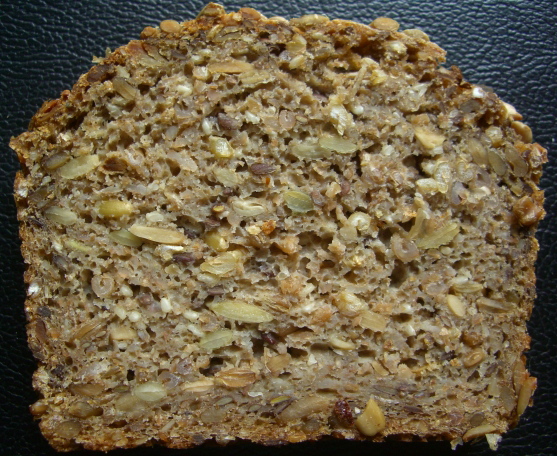
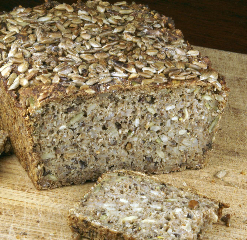
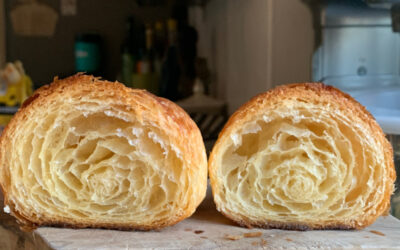
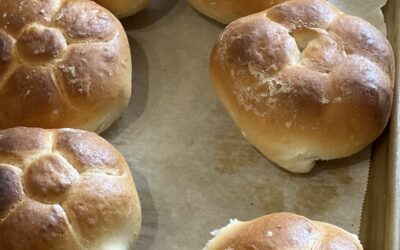

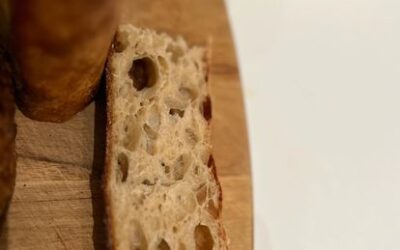
Both bread look really beautiful. The process scared me, but it seems like worth trying.
That’s one VERY handsome way of making whole grains stand upright 🙂
Great loaves, Susan and Jeremy! I hope this is not the final installment of the “stirthepots-and-wildyeast-bake-exotic-breads-together” series?
What’s the best topping on a slice of genuine Hamster? Would you go with cured fish or Nils’ favourite (salami, cheese and mustard)? 😉
Elra, try it you will like it!
Hans Joakim, I am sure we will have some co-baking/blogs in the future, just if I get more time,work has a way of hampering that!
Cheese is definitely a great choice, but leberwurst would be wonderful too, anything porcine or dairy!;-)
Really wonderful looking bread. It makes me want to try it!
Have you tried the dense rye in Hamelman’s book? I’ve been curious about that one.
Very interesting…it seems that the breads are really tasty, with all the ingredients that you have in it. Sounds really good.
Excellent! Holy grail? I hope and think the successful ending to that quest will soon be here. Or in your kitchens rather.
Jeremy, please pardon my bad manners, I totally neglected to say, in my piece, thanks for baking this with me!
Juliana, it was delicious!
Nils, I can only thank you for helping me find such wonderful rye bread!
Susan, are you ready for the next one? What shall it be, rye, kamut or spelt?
Nice, I am going to try this bread. I’ve been working with seeds lately, though toasting pumpkin and sunflower and adding it to the loaf. Love the grains in this one though
help I am new at all this would like to have some kind of chart to figure from the metric to USA my E mail is monkey185@verizon.net thank you FRANK
Beautiful bread and very very tempting! Thanks to both of you.
MC
I am curious too why this is called Black Hamster bread, so I have visited Herr Supke’s site. Based on my dodgy translating and a quick google. The black hamster is a colour mutation of the european wild hamster, larger than the pet (syrian) hamster, only found in certain parts of Europe, but Herr Supke has seen them near where he lives. And I think there might be a pun involved Hamsterbacken = hamster cheeks so a hamster bread would be stuffed with grains like a hamster’s cheeks and dark with malt to get the dark colouring. Now all I have to do is have a go at the bread itself. What a challenge!